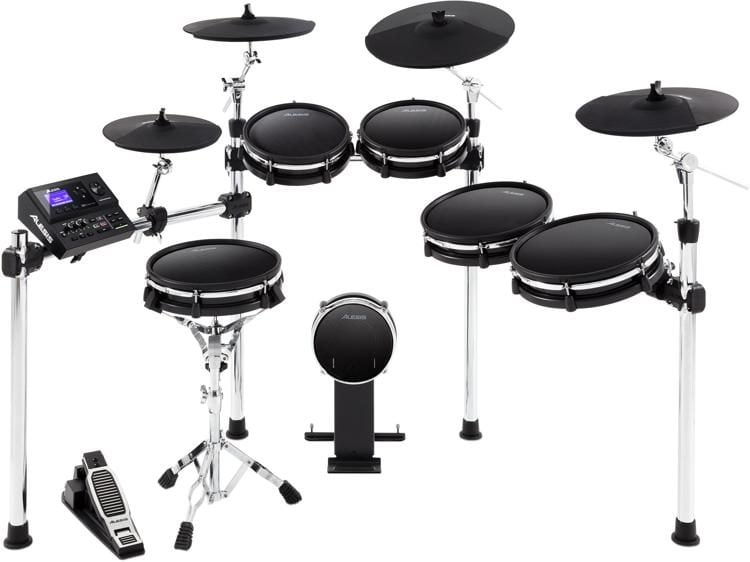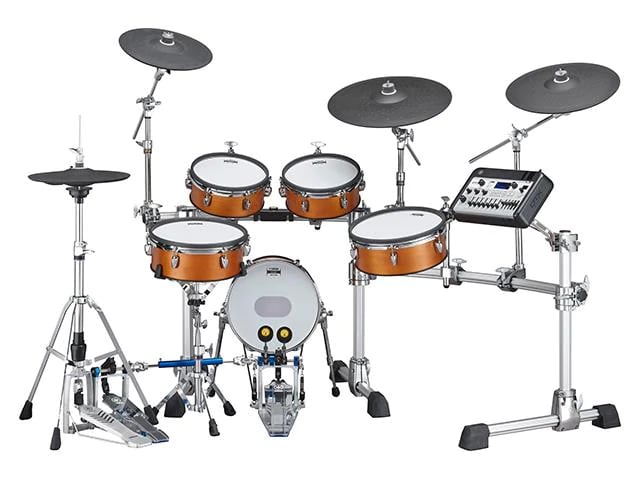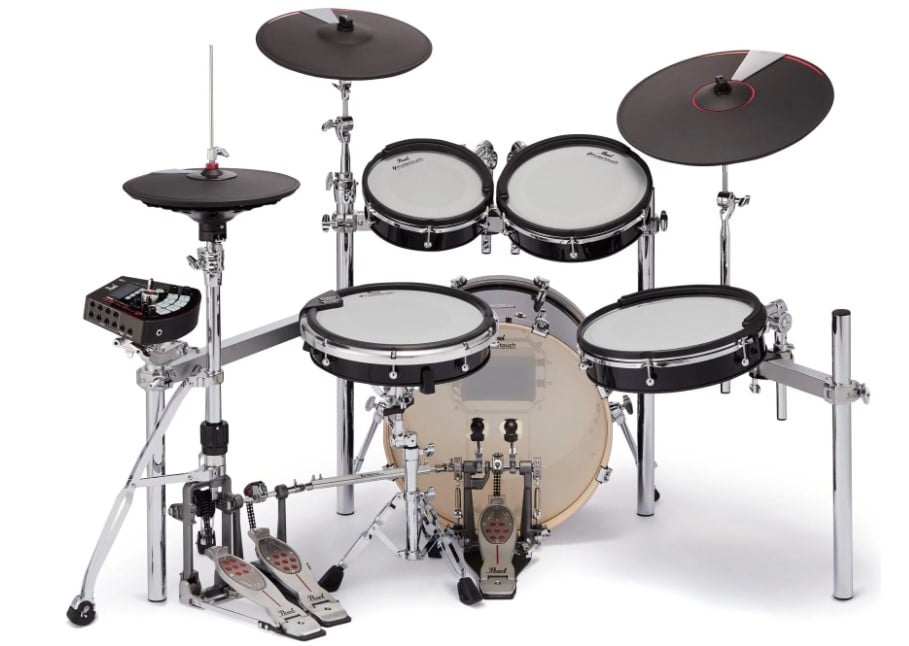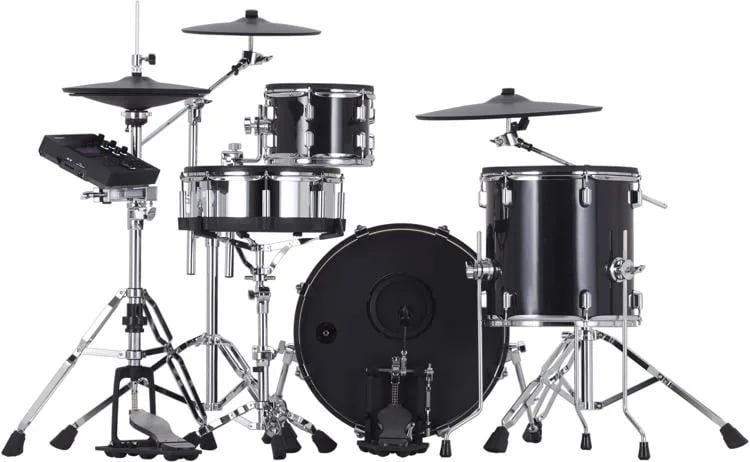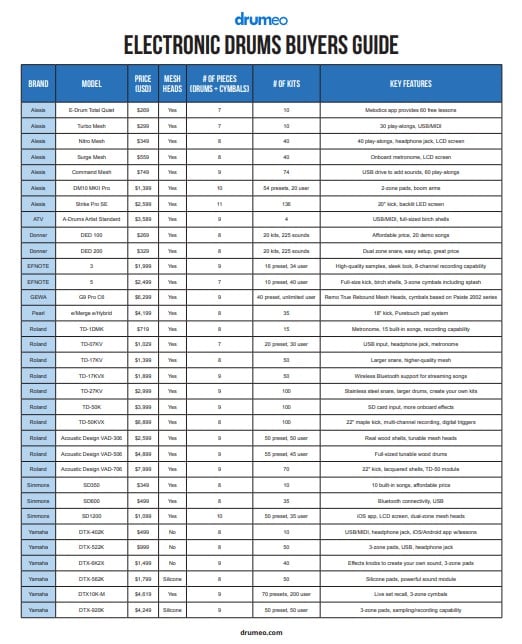Drumeo Kids App
YouTube
TikTok
FAQs
The 13 Best Electronic Drum Sets For Any Budget (Updated 2024)
Drumeo Team / UPDATED Mar 25, 2024
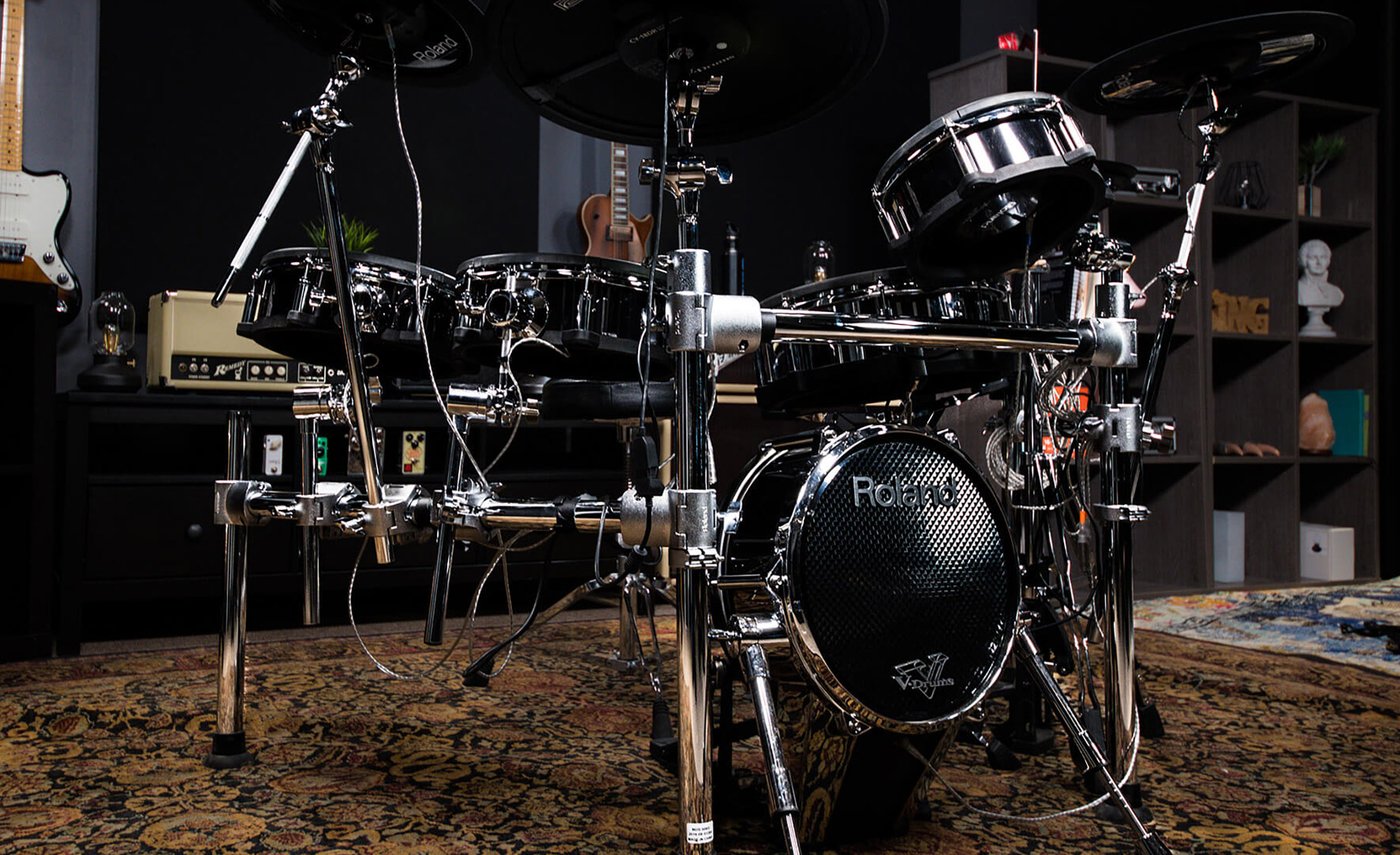
This guide will cover some of the best electronic kits at different prices (updated for 2023) and help you find the perfect fit for your apartment, garage, or studio.
Electronic drums have come a long way since the days of sterile rubber pads that felt more like kitchen counters than real drums. The sounds are better, the hardware is sturdier, and the designs are sleek and inspiring.
There are also more brands and models to choose from. Many are cheap and functional, while others have a ton of features but will cost more in return. With so many choices, how do you find the right one?
Drumeo has 9 electronic drum kits and 62 acoustic kits between our studio and warehouse. We’ve spent years getting to know the products on the market and even researching the history of electronic drums. We put together this guide based on personal experience with these products, and we hope it’ll help you find the kit that’s best for you.
Table of Contents
Here are a few options in each price range to get you started. Since there are so many kits on the market, we’ve also included a table at the end of this guide with even more options.
(All prices listed in USD and subject to market changes)
Keep in mind that most electronic kits don’t come with a drum throne, so you’ll probably need to buy a seat!
Beginner Electronic Drum Sets (Under $1000)
| Brand/Model | Price |
| Yamaha DTX-402K | $499 |
| Roland TD-02KV | $599 |
| Alesis Nitro Max | $499 |
| Alesis Command Mesh | $799 |
| Donner DED-200X | $460 |
Yamaha DTX-402K ($499)
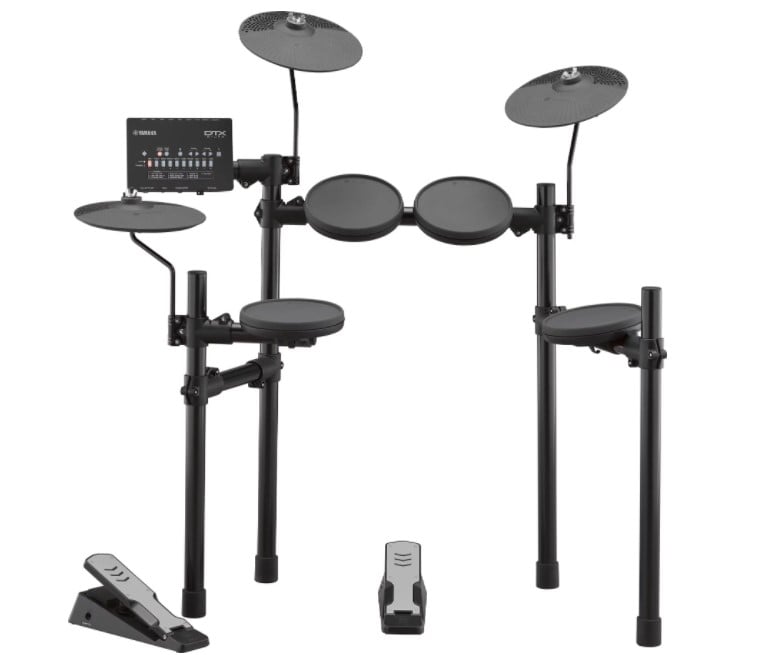
Why buy it: This kit is affordable and simple.
Toms: 3
Cymbals: 3
Kick tower: No
Snare stand: No
Hi-hat stand: No
Kick pedal: Included
Pros: The sounds are top notch – all Yamaha electronic kits feature their acoustic drum sounds built in to the sample library. This one has 10 preset kit options plus over 400 percussion and keyboard sounds. A $500 kit with the high-end sonics of the Yamaha brand? Sweet deal! This model is also compact and includes the useful DTX-40 Touch app for iOS or Android that has lessons and play-alongs. It even has a record-and-share function to help you make your first viral video. The hardware is durable, the module is functional and simple to use, and it also packs up easily if you ever need to transport it.
Cons: The rubber pads. This is a good kit if you’re just starting out or on a super-tight budget, but it doesn’t look or feel much like an acoustic drum set. This an important consideration since many students practice on an electronic kit at home and then play an acoustic one for lessons or school band. The playing action on the rubber pads is very different and could make that transition harder.
Roland TD-02KV ($549)
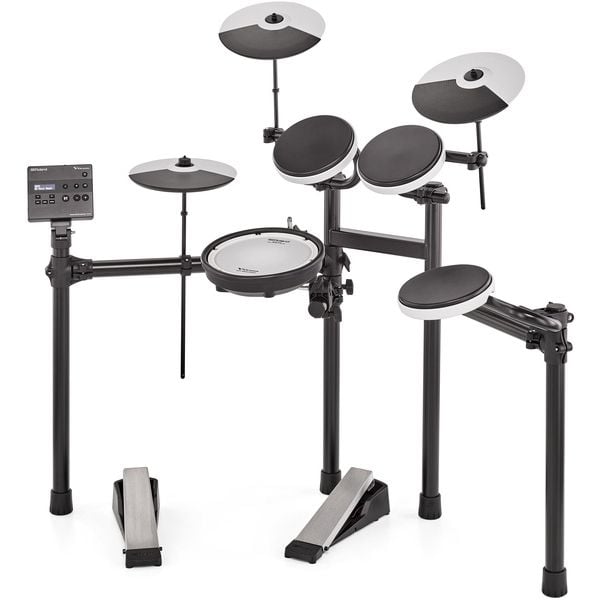
Why buy it: Most budget kits don’t come with a mesh snare (this one does!), and the beaterless kick pedal makes this an extra quiet choice.
Toms: 3
Cymbals: 3
Kick tower: No
Snare stand: No
Hi-hat stand: No
Kick pedal: Sold separately
Pros: Roland V-Drums have always been at the front of the pack when it comes to simulating the feel of real drums. With a high-quality mesh snare head (which has a better rebound and response than hard rubber) and height adjustable rack, the TD-02 is a solid starter rig for kids and adults. It has 16 built-in kits, a stereo audio input to connect to your phone, and a USB port you can use to connect MIDI instruments from your laptop. One thing that keeps many other e-kits from being totally silent is the ‘thwack’ from the bass drum pedal – but this one doesn’t have a beater!
Cons: The price is higher than other entry-level kits. The module is also fairly basic and may not have enough features and flexibility for intermediate players.
Alesis Nitro Max Drumeo Edition ($499)
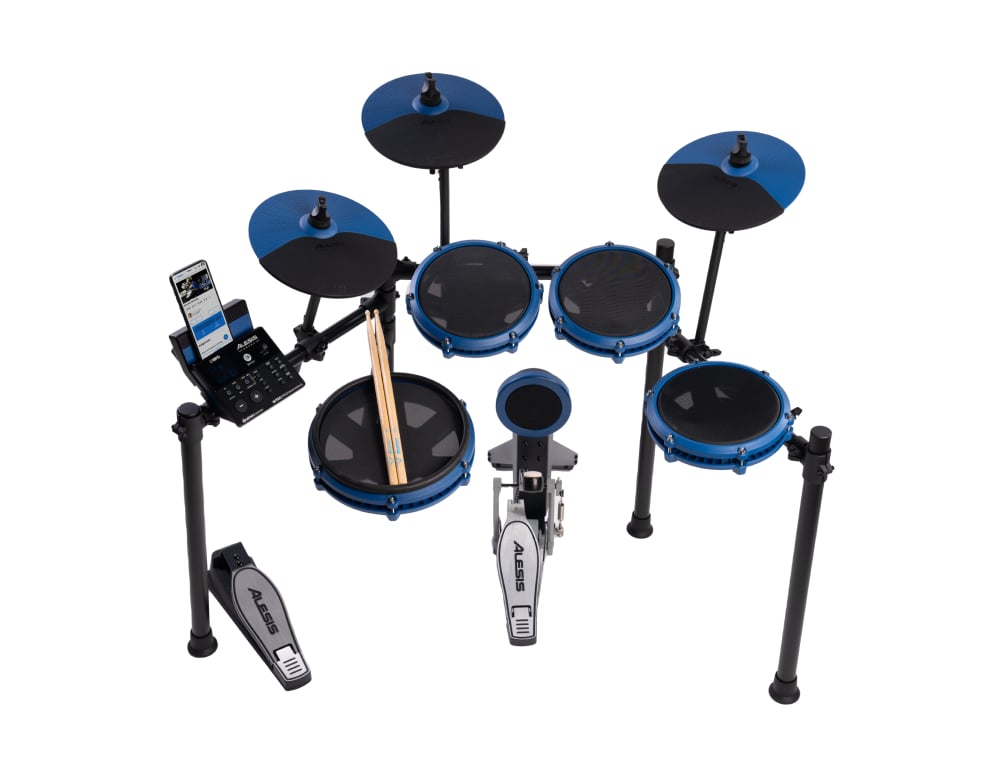
Why buy it: Mesh heads are rare at this price point, and so are kick towers. It’s a great starter kit.
Toms: 3
Cymbals: 3
Kick tower: Yes
Snare stand: No
Hi-hat stand: No
Kick pedal: Included
Pros: An all-mesh kit for under $500 is a good deal, and the freshly upgraded Nitro Max from Alesis has a lot of useful features. It offers a 10” dual-zone snare, 3 toms, two cymbals, a hi-hat, and a kick pedal. It has 32 different preset kit options and 60 play-along tracks, and also comes with cables, a pair of sticks, and a drum key to get you going right away. It’s compact, connects to your device via Bluetooth, and has a simple, user-friendly module.
For a step up, the Alesis Command Mesh model ($799) is a similar rig with a few more bells and whistles (like a bigger kick pad, additional sounds and customization options).
Cons: The aluminum rack it’s mounted on could also be sturdier and the cymbals are a bit clunky. As Brooklyn Guitar Center salesman and electronic drum expert Ozzie Martinez explains, “With the Alesis kits, people tend to buy the inexpensive ones and use them to trigger their own [custom] sounds.”
Donner DED-200X ($460)
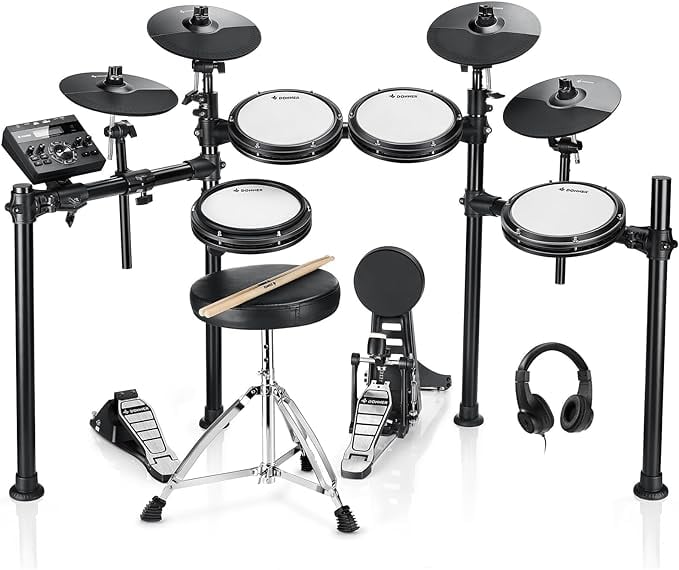
Why buy it: Small enough for a kid’s bedroom.
Toms: 3
Cymbals: 4
Kick tower: Yes
Snare stand: No
Hi-hat stand: No
Kick pedal: Included
Pros: You can’t beat (pun intended) 5 mesh drum pads and 4 cymbals for this price. Donner is an under-the-radar brand for parents who want to get their kids started on drums without making a huge investment. This unit is small enough to fit into the corner of your bedroom and features 31 kit presets, 450+ sounds, and 50 built-in play-alongs to get you started.
Cons: The price is good, but the quality…we’re not sure. Some users have reported issues with the responsiveness of these drums, while others like the feel compared to other kits in this price range. The DED-100 ($350) is an even cheaper option that has a flimsier frame, shallower pads, and no actual bass drum (just a trigger pedal). If you decide to go with this brand, the 200X model is a better bet.
Intermediate Electronic Drum Sets ($1000-$3000)
| Brand/Model | Price |
| Yamaha DTX6K2-X (rubber heads) | $1600 |
| Yamaha DTX6K3-X (mesh heads) | $1900 |
| Roland TD-17KV | $1500 |
| Roland TD-17KVX (extra cymbal and hi-hat stand) | $2000 |
| Alesis DM10 | $1400 |
| Alesis Strike Pro SE | $2500 |
Yamaha DTX6K2-X ($1600)
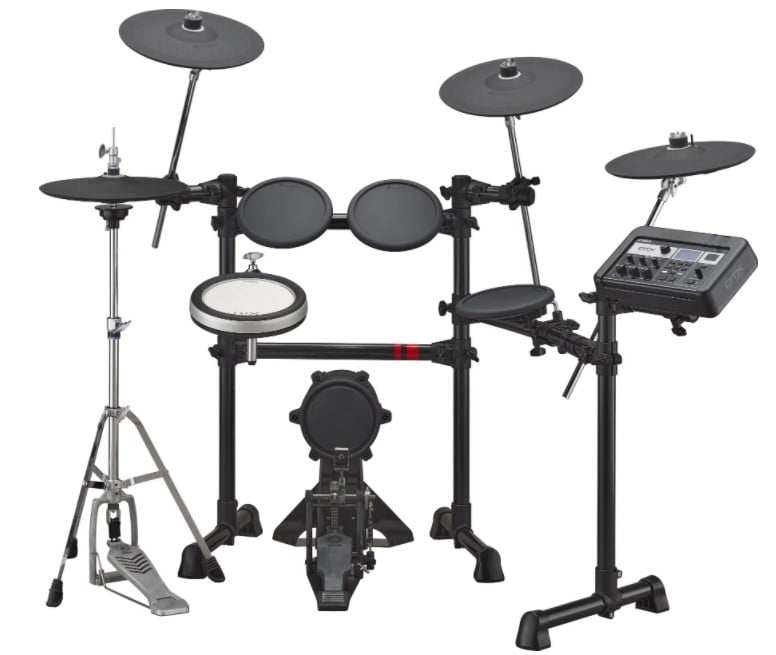
Why buy it: Full-sized hi-hat, plenty of sound options.
Toms: 3
Cymbals: 4
Kick tower: Yes
Snare stand: No
Hi-hat stand: Sold separately
Kick pedal: Sold separately
Pros: This new release from Yamaha features killer drum sounds along with increased pad sensitivity for a more realistic playing experience. You can also have a blast creating your own sounds in real-time using the effects knobs on the module. It has a full-sized hi-hat stand and a study kick drum pad which, despite the larger footprint, are both nice additions.
The kick drum mount also has a softer playing surface to make it feel more like a real bass drum. The rubber cymbals are a bit thinner than entry-level models and tend to move more like metal ones when you hit them. This is one big difference you’ll notice across the board when you step up from the beginner kits to mid-level options.
Cons: The toms are rubber pads, while the snare has a silicon-based head called the TCS which is like a softer version of the mesh heads. However, for $300 more, you can upgrade to the 6K3-X series which has TCS heads on all the drums. Some drummers love these, while others find them to be too far removed from the feel of an acoustic drum. Try them out at your local drum shop if you can!
Roland TD-17KV ($1500)
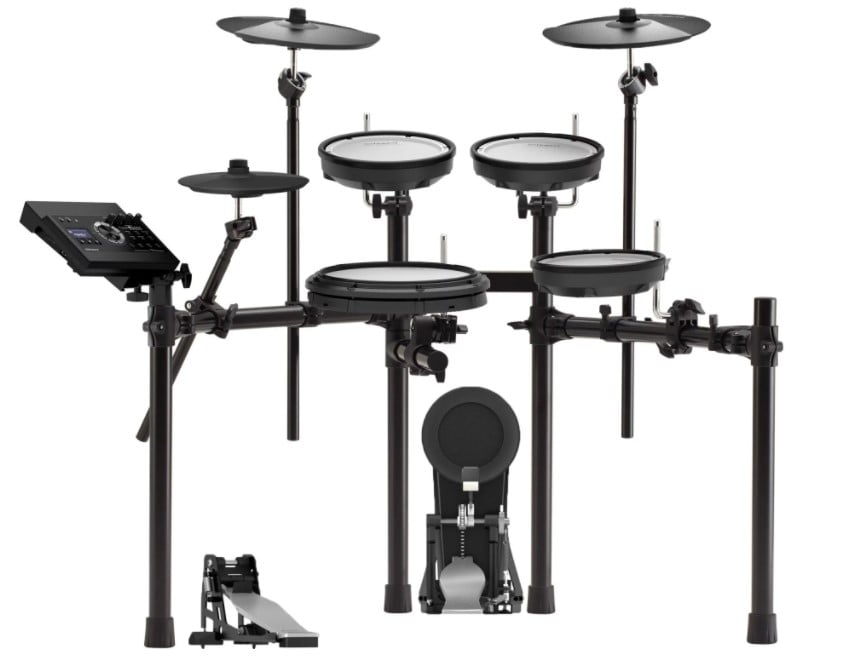
Why buy it: Most kits at this price point don’t let you import your own sounds. This one does!
Toms: 3
Cymbals: 3
Kick tower: Yes
Snare stand: No
Hi-hat stand: No
Kick pedal: No
Pros: The snare! It’s 12” of double-mesh and we’re excited to shed some rudiments on a super-realistic playing surface (that’s also tunable). This kit has 50 preset kit sounds from the higher-end TD-50 module and includes two 8” mesh toms, two 12” cymbals, and a 10” hi-hat. It’s also compact and has USB connectivity and an SD card slot so you can bring in your own sounds.
The TD-17KVX model is $500 more and adds one additional ride cymbal and hi-hat pads you use with a full-sized hi-hat stand (not included).
Cons: The 8” toms feel a bit small compared to the larger snare. The hi-hat mechanism is also lacking compared to the KVX model, but we’re not sure if that’s worth the extra $500. While the ride cymbal has 3 playing zones (ride/crash/bell), the other cymbals are dual-zone and don’t have a bell sound option.
You could also save a couple bucks and downgrade to the TD-07KV ($1029) which has smaller pads and a standalone hi-hat pedal. However, we think the TD-17KV hits the sweet spot as far as price and features that offer the best value.
If you’re going to spend $1000 and get into the mid-range kits, you might as well spend a few dollars more and get something a little nicer.
Alesis DM10 MKII Pro ($1400)
Why buy it: Dual-zone cymbals, adjustable mesh heads and bigger pads.
Toms: 4
Cymbals: 4
Kick tower: Yes
Snare stand: Included
Hi-hat stand: No
Kick pedal: Sold separately
Pros: Most electronic drums in this price range don’t come with dual-zone cymbals (this one has a triple-zone ride) or an extra tom, so you’re really getting that ‘bigger kit’ experience without the higher price tag. Adjustable mesh heads and bigger velocity-sensitive pads give a natural response that feel a lot like acoustic drums, and – unlike most entry-to-mid-level options – this one comes with boom arms! The module has 50 preset kits, which you can customize with your preferred levels of reverb, compression and more. If you don’t like the stock samples, you can import your own.
Cons: The DM10 has a bigger footprint than most other mid-range kits, so you’ll need a bit more space. The kick tower is relatively loud (it ‘clangs’ somewhat), so keep that in mind too. The kit doesn’t have a full hi-hat setup, which may seem odd considering it has extra toms and cymbals.
For those with a bigger budget, you can try the Alesis Strike Pro SE ($2500), which has larger toms, a full-sized bass drum, and even more cymbals.
Professional Electronic Drum Sets (Over $3000)
| Brand/Model | Price |
| Roland TD-50K | $6000+ |
| Yamaha DTX10K-M | $4619 |
| Pearl e/Merge e/Hybrid | $4130 |
| Roland V-Drums Acoustic Design VAD 504 | $4000 |
| GEWA G9-Pro C6 | $5500 |
Roland TD-50K Series ($6000+)
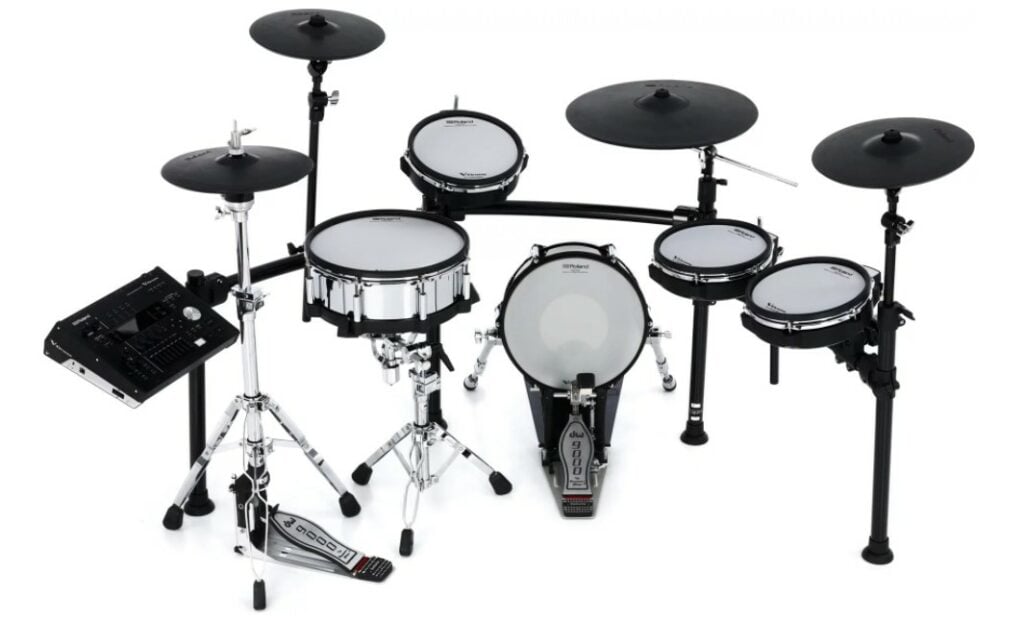
Why buy it: Realistic snare drum, XLR stereo out, bigger kick pad.
Toms: 3
Cymbals: 4
Kick tower: Yes
Snare stand: Sold separately
Hi-hat stand: Sold separately
Kick pedal: Sold separately
Pros: The TD-50 series is one of the jewels of the Roland brand, and it’s easy to see why it’s so popular. This is a kit that you can actually take to a gig since it has an XLR stereo output you can send directly to the sound system. It also has an SD card input so you can easily bring in any sounds you want, and it’s great for recording since you can connect directly to your DAW via USB and capture up to 10 channels at once.
It also has some of the most realistic electronic cymbals on the market including an 18” ride, a couple of crashes (12” and 13”), and an 11” hi-hat that you mount on a traditional hi-hat stand (sold separately). This kit is good for pros and serious hobbyists alike, and you really can’t go wrong with V-Drums.
The upgraded TD-50KV2 model ($8400) has a full 14” hi-hat, deeper toms, a bigger bass drum, and a sturdier rack.
Cons: If you’re trying to fit this into a small space, you’re probably out of luck. While it’s smaller than some of the hybrid models, the TD-50K base model is still almost 5 feet wide and 4 feet deep. You’ll also need to shell out separately for the bass drum pedal, hi-hat stand, and throne.
Yamaha DTX10K-M ($4619)
Why buy it: Real wood shells, 3-zone cymbal pads, Live Set recall and more.
Toms: 3
Cymbals: 4
Kick tower: Yes
Snare stand: Sold separately
Hi-hat stand: Included
Kick pedal: Sold separately
Pros: The DTX10 is one of Yamaha’s flagship electronic kits and there’s a whole lot to like here. One highlight is the Yamaha sound library, which features great acoustic kit sounds and synth options. Like many other kits in this price range, it has easy USB compatibility for bringing in your own sounds, multi-track recording (this kit comes with Cubase software), and playing live on stage. You can program your favorite settings into the ‘Live Set’ function and apply them to the kit instantly with the push of a button. The crashes and ride come with 3-zone pads for extra detailed playing.
Cons: As we mentioned earlier, the silicon-based TCS heads are a hotly debated topic among drummers who believe they don’t offer the same feel and responsiveness as mesh – so while you have the option to choose between the two materials with this kit, we’re only including the mesh version here. Like many other high-end models, this kit also has a larger footprint to consider if you’re trying to stash it in the corner of your bedroom or set it up on a small club stage.
Pearl e/Merge e/Hybrid ($4130)
Why buy it: Full-sized pads, full-sized (18″) bass drum, great samples…the list goes on and on.
Toms: 3
Cymbals: 3
Kick tower: Yes…a full-sized bass drum!
Snare stand: Included
Hi-hat stand: Sold separately
Kick pedal: Sold separately
Pros: Pearl and Korg teamed up to create this high-end kit and it’s impressive. It has an 18” bass drum that looks just like an acoustic drum and uses the PureTouch electronic pad system, which makes the drums and cymbals feel closer to the real thing. The attention to detail on this kit is off the charts, and the module is sleek and easy to use. It has 35 drum set options and a ton of real Pearl drum samples to choose from. The chrome-plated hardware rack is sturdy and solid.
Cons: Price. This is a lot to spend on a kit and it’s not going to be easy to fit into a smaller space. For $200 less, Pearl offers an e/Traditional version of this kit without the full-sized bass drum, but even that still takes up a good amount of space.
Roland V-Drums Acoustic Design VAD 504 ($4000)
Why buy it: Real wood shells, detailed sound customization, full-sized drums, realistic feel and more!
Toms: 2
Cymbals: 3
Kick tower: Yes…a full-sized bass drum!
Snare stand: Sold separately
Hi-hat stand: Sold separately
Kick pedal: Sold separately
Pros: With real wood shells, these beauties look like acoustic drums. They include the easy-to-use TD-27 module with tons of features to EQ, tune and manipulate your sound. The cymbals are thinner than many others and have good sensitivity and response. This is a great choice for those who want an electronic experience that simulates an acoustic kit, and Roland has been at the front of the pack of the electronic drums market for many years.
Cons: Your wallet might cry a little, especially since this price doesn’t include some of the necessary hardware. Roland does offer the similar VAD 307 model ($2500) for drummers who want to experience some of these high-level features on a tighter budget. The 307 uses the TD-17 module and has shallower shells (but it does include an extra tom and cymbal). There’s also the breathtakingly beautiful 706 model with even more features, which will set you back a cool $8000.
GEWA G9-Pro 5 SE ($5150)
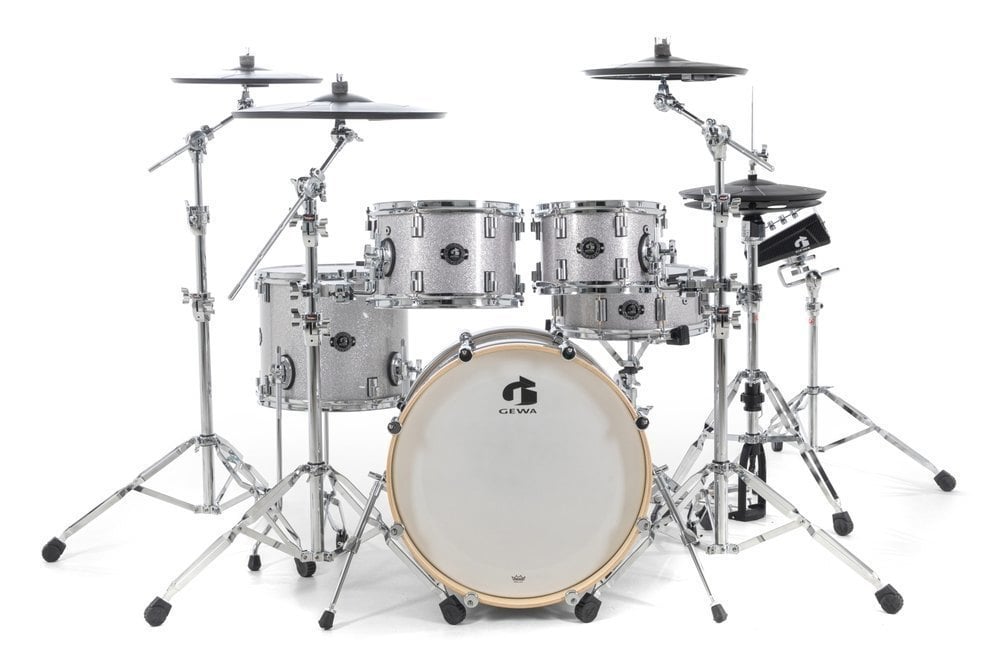
Why buy it: Full-sized shells, great hardware, touch screen module, great sound library.
Toms: 3
Cymbals: 4
Kick tower: Yes…a full-sized bass drum!
Snare stand: Sold separately
Hi-hat stand: Included
Kick pedal: Sold separately
Pros: GEWA offers some of the most interesting high-end kits out there. Their G9-Pro 5 SE model features full-sized shells (10”/12”/14”/20”), Gibraltar hardware, and cymbals modeled after the popular Paiste 2002 Series.
GEWA partnered with Remo to make some impressive True Rebound mesh heads based on the Ambassador. They’re like 2-ply versions of the Remo Silentstroke heads (which are single-ply). This design team definitely heard the calls from drummers who want electronic kits to feel more like acoustics.
This model has a super slick direct-touch interface and plenty of functionality for pro audio recording and adding effects. The module even comes with WiFi and Bluetooth. This kit is amazing! But…
Cons: With a price tag over $5000, it’s out of reach for many buyers. It also has a large footprint and the futuristic carbon-wrapped shells and industrial-looking cymbals may not appeal to everyone. You do get a lot for your money, and we look forward to seeing if GEWA is able to come up with a more competitively-priced option to contend with other brands in the mid-tier e-drums market.
The alternative: Build a hybrid kit
Pros: Don’t like any of these choices? Build a franken-kit! Many drummers use triggers, a module, and silent drum heads to create a fully customizable e-drum playing experience at a lower cost.
You can start by picking up a module like the Roland TD-17 ($800), the Yamaha DTX Pro ($859), or the Pearl Mimic Pro ($2550).
Then grab a set of triggers like this cost-effective set of 5 Ddrum red shots ($99) or the highly regarded Yamaha DT50s ($99/each).
Top it off with a pack of Remo Silentstroke heads ($123) and presto, you’ve transformed your acoustic kit!
Cons: Going this route takes more time and research. Another big issue is compatibility. Will all these parts work together? Will the triggers be responsive and sensitive? How will it sound? What cables and adapters will I need? This option also does not solve any issues with fitting the kit into a smaller space.
There are so many options. However, you tend to get what you pay for. The cheapest kits are good to get you started, but if you decide to upgrade, spend the extra cash for quality products like the Roland TD-17, TD-27, or Yamaha DTX10K-M.
The highest-end models like the Roland TD-50 and the Pearl e/Merge Hybrid offer a ton of features, but many are just as space-consuming as an acoustic kit and extremely pricey. Go to the store, test out everything, and find one that fits your budget and inspires you to rock out!
Compare all these kits side by side
Want to look at your options in one convenient, easy-to-browse place? Click here for a table that compares models, prices, features, and more.
What to look for when buying an electronic drum set
If you’ve never bought electronic drums before, it can feel like buying a computer for the first time: there are so many specs and features, you have no idea where to start.
Don’t let the paradox of choice stop you from moving forward on your new dream kit. Here are a few things to consider:
Do the drums have mesh or rubber heads? Do they feel good to play?
Mesh comes with a better feel and more realistic rebound. They’re also quieter when you hit them, which is important since many people choose electronic kits because they don’t make a lot of noise (sleeping children, nosy neighbors, skittish pets). Mesh heads are tunable so you can change the rebound – which isn’t possible with a rubber pad.
How are the triggers?
Do you get a good trigger response? What does it sound like when you hit the pads? Does the sample trigger right away? Do you have options to adjust the velocity and dynamics so your drum rolls don’t sound like machine guns firing?
Are the cymbals thick or thin?
If they’re made of thick, unforgiving rubber, it will be hard to simulate the rebound and feel of a real cymbal. Some of the higher-end kits have thinner cymbals that actually move more like metal ones when you hit them.
Is the hardware sturdy?
It’s no fun buying a new instrument and having it fall apart after a few months. Durability is important. And if you plan on moving it around or gigging with it, how easy is it to fold up the rack?The quality and responsiveness of the drum pads greatly affect your playing experience. Look for pads that offer a natural feel and response, resembling the rebound and sensitivity of acoustic drums. Consider the number of drum pads and cymbals included, ensuring they meet your specific needs. Furthermore, pay attention to the triggering technology used, such as mesh heads or rubber pads, as this affects the accuracy and dynamics of your playing.
How much space do the drums take up?
Besides the noise, many people choose electronic kits because they don’t have room for a large acoustic setup. Make sure to measure your space before you buy!
What kind of features does the module have?
On an acoustic drum set, you can sit down and play without dealing with electronics and wires. All electronic kits have a module or “brain” that controls everything, and the interface is different for each brand. Check out the display screen. Is it small and grainy, or pleasing to the eye? Are the commands user-friendly? Is the built-in metronome easy to use, and how easy is it to switch between samples? Does it have Bluetooth? Can you connect it to your phone or laptop?
How does it sound?
Some people choose electronic kits because they want more sonic options, and more volume control and consistency than what an acoustic kit can offer. All the kits listed below have a ton of different drum sounds, and it’s important to pick something that you think sounds good and inspires you to play. Often you’ll be using headphones, but also consider how it sounds through an amp or speaker if you want to use it for band practice or a lesson.
Does it have good response?
You might find it frustrating if you hit an electronic pad or step on a hi-hat pedal and hear a split-second delay in the sound.
Does it have any fun extra features?
Some kits let you attach external USB devices and bring in your own sound sample library (Superior Drummer, Get Good Drums, and SSD are a few examples). Many also have built-in play-along tracks and even let you change the room tone so it sounds like you’re playing in different places (it’s like drum tourism)!
Can you add pieces to the kit later?
If you ever want to expand the get or get more creative by adding extra pads or cymbals, find out if it’s possible on your model. Entry-level kits might not have this option. If you don’t want to use headphones (for example, you’re playing a gig or jamming with friends) you might decide you want to use an amp to project the sound of your kit. Find out what types of amps it’s compatible with.
Are you comfortable playing it?
Does it feel like a real kit or a toy? Will this instrument enhance your playing or inhibit it? Are the toms 6” wide and squished together, or does it feel almost like a real kit? Drummers come in all shapes and sizes, so what’s right for someone else might not be a good fit for you. Go to the store and try some stuff out!
Is it in your budget?
If you’re a beginner who isn’t sure if drumming will be a long-term endeavor, a lower end kit is fine for jamming at home. But if you’re serious about it, investing in something higher end could be a better choice. While electronic equipment tends to have questionable longevity – and a good electronic drum kit can run you back thousands of dollars – the mid-to-high-end kits mentioned on this page are well made by reliable companies with good customer service.
If you’re still unsure about if electronic drums are right for you, click here.
Are electronic drums quiet?
Yes, electronic drums are quiet – to an extent. They’re much quieter than acoustic drums because they’re built from quieter materials.
The reason people often choose electronic drums is because they use triggers. Rather than needing to strike the surface to produce a raw, intense sound upon impact, triggers play an electronic sound sample when your stick makes contact with the pad. Since the pads are relatively quiet, this means you can control the volume – and even have it only audible through headphones.
While mesh heads will give you a much quieter result than rubber pads, the thumping of your beater(s) against the kick tower can sometimes still be felt through an apartment wall (Read: Tips for drumming in an apartment). You may still want to check with your neighbors.
But overall, if you share a space with others, live in a multi-unit building or only have time to practice late at night, an electronic drum set is definitely the best way to play drums quietly.
Are electronic drums easier to play than acoustic drums?
Depending on the size and quality of the pads, an electronic drum kit can make a drummer sound slightly better compared to an acoustic kit. The drum samples are typically compressed and mixed and have a limited range of velocities (especially lower-end kits), so even poor technique can produce a good sound. The better you think you sound, the better you’ll feel about your playing, and you might even play better as a result!
Most electronic drum sets have smaller pads, which means you can move them closer to you. Drummers play best when everything is in reach, and smaller pads make it easier to get everything right where you want it.
Are electronic drums good for beginners?
Electronic drums are great for beginners. On top of smaller pads and pro-sounding drum samples, the rebound on electronic pads (whether mesh or rubber) is higher than on an acoustic kit, so it’s easier to play fast and move around the drums.
They take up less space than traditional drums and are even easier to set up. You can get a used, entry-level electronic kit for around the same price as an acoustic kit.
Where can you buy a used electronic drum set?
Check your local online marketplace (Craigslist, Facebook Marketplace) to see if there’s anyone selling electronic drums in your area. If not, try the local music store; some sell used products. The other option is to check online on sites like Reverb.com, GuitarCenter.com, eBay or Sweetwater Gear Exchange. You’ll have to pay shipping, but a good deal’s a good deal.
Are electronic drums better than acoustic drums?
We won’t say an electronic kit is better than an acoustic kit, or vice versa: they’re both awesome in different ways.
Why acoustic drums are better:
- They’re often cheaper than electronic kits
- Most drummers use acoustic drums live and in the studio
- It’s easier to jam with other musicians (no amp required)
- It might feel more satisfying to play an acoustic kit
Why electronic drums are better:
- They’re much quieter than acoustic kits
- They tend to take up less space
- You can get hundreds of sounds out of a single kit
- They’re easier to record and edit
How do you record with an electronic drum kit?
If your electronic kit has the ability to connect to a computer – usually with a USB cable – you can record your electric drumming directly into a DAW (Digital Audio Workstation) or even right into your phone (with a USB adapter or an iRig, which you can get for $50).
You’ll want to look up your drum set’s user manual to learn how to set up MIDI or instrument tracks and more. You can also find some helpful tips in this guide from Sweetwater.
What’s the best electronic drum kit brand?
It’s hard to choose favorites, but some of the most reliable electronic drum set companies are Roland and Yamaha. GEWA has recently become a strong player in the high-end market, and Alesis‘ lower-end kits offer serious value (although some users have taken issue with their durability).
Whichever kit you choose, there’s one thing you do know for sure: you’ll be drumming, and that’s the most important thing!
*This article contains affiliate links, which means we might earn a small commission from the product seller if you make a purchase. For more info, check out our privacy page.
Edited by Sam Landa, Content Marketing Manager at Drumeo
SHARE THIS:
Drumeo Team - We're professional, award-winning drummers and drum teachers, coaches, recording artists, and content specialists who are passionate about drums and helping drummers around the world. This post was written and/or edited by Sam Landa, Brandon Toews, Jared Falk, Dave Atkinson, or another pro on our team (which has a combined 1000+ years of drumming experience). Are you looking for inspiration, education, and support to take your playing to the next level? Join the Drumeo community today!
Related Posts


Improve your speed on the drums with El Estepario Siberiano’s FREE course.
Enter your email to get all 10 exercises sent to your inbox.
By signing up you’ll also receive our ongoing free lessons and special offers. Don’t worry, we value your privacy and you can unsubscribe at any time.
We use cookies for traffic data and advertising. Cookie Policy »



